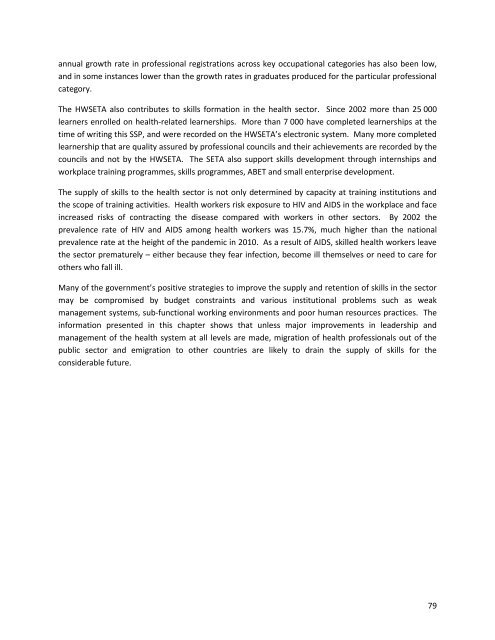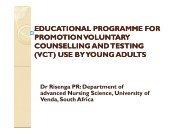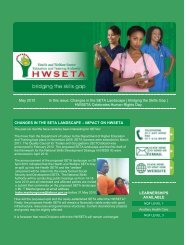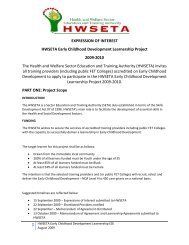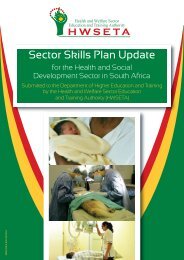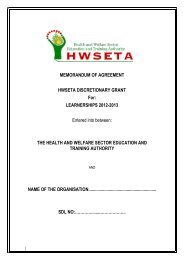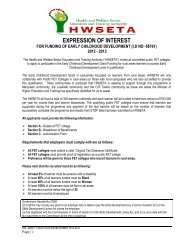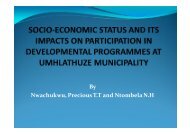sector skills plan for the health sector in south africa
sector skills plan for the health sector in south africa
sector skills plan for the health sector in south africa
You also want an ePaper? Increase the reach of your titles
YUMPU automatically turns print PDFs into web optimized ePapers that Google loves.
annual growth rate <strong>in</strong> professional registrations across key occupational categories has also been low,<br />
and <strong>in</strong> some <strong>in</strong>stances lower than <strong>the</strong> growth rates <strong>in</strong> graduates produced <strong>for</strong> <strong>the</strong> particular professional<br />
category.<br />
The HWSETA also contributes to <strong>skills</strong> <strong>for</strong>mation <strong>in</strong> <strong>the</strong> <strong>health</strong> <strong>sector</strong>. S<strong>in</strong>ce 2002 more than 25 000<br />
learners enrolled on <strong>health</strong>-related learnerships. More than 7 000 have completed learnerships at <strong>the</strong><br />
time of writ<strong>in</strong>g this SSP, and were recorded on <strong>the</strong> HWSETA’s electronic system. Many more completed<br />
learnership that are quality assured by professional councils and <strong>the</strong>ir achievements are recorded by <strong>the</strong><br />
councils and not by <strong>the</strong> HWSETA. The SETA also support <strong>skills</strong> development through <strong>in</strong>ternships and<br />
workplace tra<strong>in</strong><strong>in</strong>g programmes, <strong>skills</strong> programmes, ABET and small enterprise development.<br />
The supply of <strong>skills</strong> to <strong>the</strong> <strong>health</strong> <strong>sector</strong> is not only determ<strong>in</strong>ed by capacity at tra<strong>in</strong><strong>in</strong>g <strong>in</strong>stitutions and<br />
<strong>the</strong> scope of tra<strong>in</strong><strong>in</strong>g activities. Health workers risk exposure to HIV and AIDS <strong>in</strong> <strong>the</strong> workplace and face<br />
<strong>in</strong>creased risks of contract<strong>in</strong>g <strong>the</strong> disease compared with workers <strong>in</strong> o<strong>the</strong>r <strong>sector</strong>s. By 2002 <strong>the</strong><br />
prevalence rate of HIV and AIDS among <strong>health</strong> workers was 15.7%, much higher than <strong>the</strong> national<br />
prevalence rate at <strong>the</strong> height of <strong>the</strong> pandemic <strong>in</strong> 2010. As a result of AIDS, skilled <strong>health</strong> workers leave<br />
<strong>the</strong> <strong>sector</strong> prematurely – ei<strong>the</strong>r because <strong>the</strong>y fear <strong>in</strong>fection, become ill <strong>the</strong>mselves or need to care <strong>for</strong><br />
o<strong>the</strong>rs who fall ill.<br />
Many of <strong>the</strong> government’s positive strategies to improve <strong>the</strong> supply and retention of <strong>skills</strong> <strong>in</strong> <strong>the</strong> <strong>sector</strong><br />
may be compromised by budget constra<strong>in</strong>ts and various <strong>in</strong>stitutional problems such as weak<br />
management systems, sub-functional work<strong>in</strong>g environments and poor human resources practices. The<br />
<strong>in</strong><strong>for</strong>mation presented <strong>in</strong> this chapter shows that unless major improvements <strong>in</strong> leadership and<br />
management of <strong>the</strong> <strong>health</strong> system at all levels are made, migration of <strong>health</strong> professionals out of <strong>the</strong><br />
public <strong>sector</strong> and emigration to o<strong>the</strong>r countries are likely to dra<strong>in</strong> <strong>the</strong> supply of <strong>skills</strong> <strong>for</strong> <strong>the</strong><br />
considerable future.<br />
79


